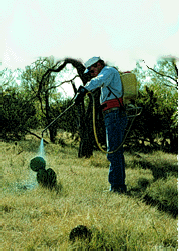Works Best:
On relatively thin stands of pricklypear, tasajillo (pencil cholla), tree cholla, dog cactus and other species of cacti.
When to Apply:
The Brush Busters pad or stem spray method can be applied throughout the year. The herbicide used in the Brush Busters method, Surmount™ , is taken up through the pads and stems and through the roots after rains have moved the herbicide into the soil. The absence of rain for extended periods after spraying may reduce plant kill.
1. Prepare Equipment
Small pump-up garden sprayers, backpack sprayers, cattle sprayers, or sprayers mounted on 4-wheel all-terrain vehicles, (ATV’s) work well. Garden sprayers are best for small acreages. Backpack sprayers may be more efficient in dense stands or where there are dense stands of brush. ATV sprayers become more efficient on large acreages or where the plants are far apart. Make sure your sprayer has a nozzle capable of delivering a coarse spray (large droplets). A fan-type nozzle may be more efficient for large pricklypear plants, but an adjustable cone nozzle (X6 to X8) will be more efficient for smaller plants.
2. Mix Herbicide Spray
You can achieve 76% to 100% rootkill of pricklypear and and other cacti by spraying with the herbicide Surmount™. The ingredient in this product that kills pricklypear and other cacti is picloram.
To prepare the spray mix, add 1% concentration of Surmount™ to water. To ensure a thorough coating of the waxy pads or stems, add either a non-ionic surfactant or liquid dishwashing detergent to the spray mix (see table below). It will be helpful to add a spray marking dye, such as Hi-Lite™ Blue Dye, to mark plants that have been sprayed and to tell if you are getting an adequate amount of spray on the green pads or stems.
Recommended spray mixture.
| Ingredient | Concentration in spray solution | Tank Size | ||
| 3 gal. | 14 gal. | 25 gal. | ||
| Surmount™ | 1% | 4 oz. | 18 oz. | 1 qt. |
| Surfactant | 1/4% | 1 oz. | 5 oz.. | 8 oz. |
| Hi-Light Blue Dye™ | 1/4-1/2% | 1-2 oz. | 5-9 oz. | 8-16 oz. |
*All spray solutions are mixed in water.
3. Spray the Pricklypear or Other Cacti
The spray can be applied year round, except during extremely cold weather. Apply the spray until the pads or stems are almost wet, but not to the point of runoff. Results will be faster and more consistent if both sides of the prickly pear pads are sprayed. The HiLite™ Blue Dye will be most effective when the grasses growing within the cacti are dormant due to dry or cold weather.
Keep these points in mind:
- The purchase and use of Surmount™ requires a Pesticide Applicator License from the Texas Department of Agriculture. See your County Extension Agent for license information.
- Follow herbicide label directions.
- Prickly pear dies very slowly following application of pad or stem sprays. Total plant kill may take two or three years.
- Do not spray when the pads or stems are wet.
- Do not spray when air temperatures are low.
- Do not spray if you are working immediately upwind of desireable trees, shrubs, or crops.
- Do not spray within 100 feet of known sinkholes or fractures that would allow herbicide to enter underground water aquifers.
- To avoid damage to desirable trees such as live oak or pecan, do not spray dense pricklypear or other cacti growing beneath these trees.
- Cost of treatment increases rapidly as density and size of prickly pear or other cacti increases.
- Do not spray within 20 yards of the habitat of endangered plants. Check with the U.S. Fish and Wildlife Service if you need information about threatened or endangered plants in your area.
- Large prickly pear plants may be nesting sites for quail in areas where bunchgrasses are rare or heavily grazed. Prickly pear may also be of value as livestock feed during drought and as a food source for white-tailed deer or javelina in South Texas.
- Mechanical injury that bruises or punctures the surface of prickly pear pads or stems immediately before spraying will speed up and improve plant kill.
